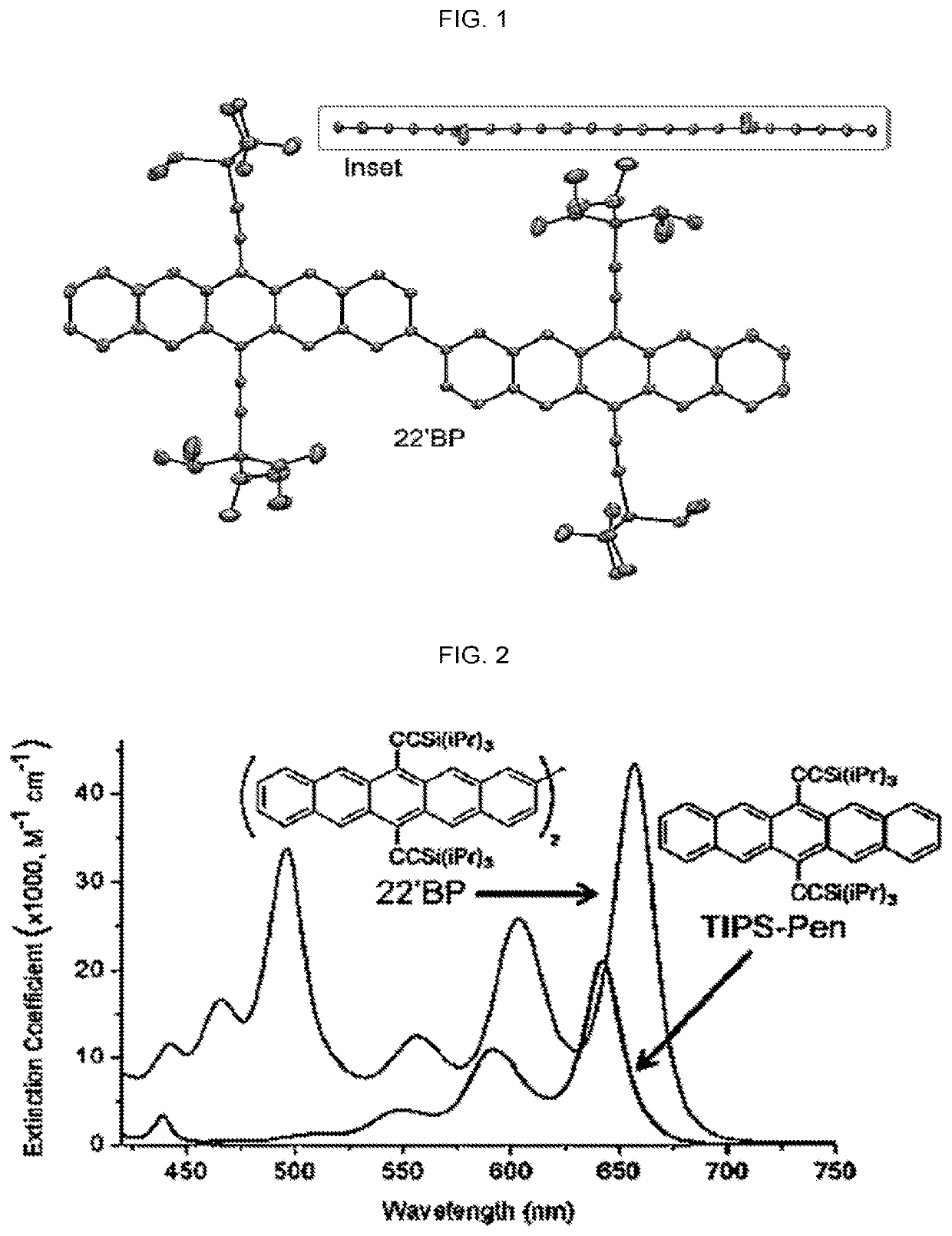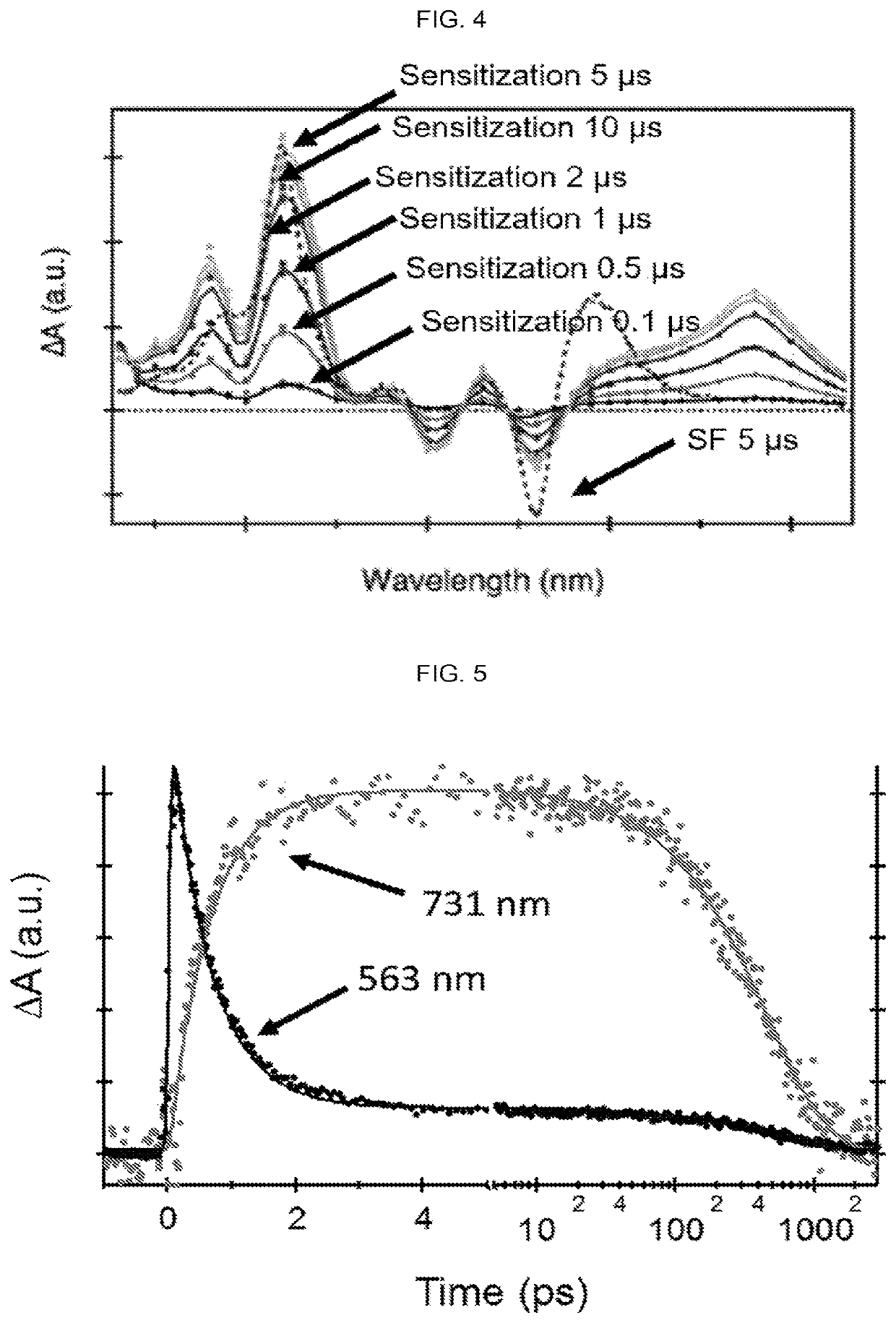Quantitative intramolecular fission in oligoacenes, materials, and methods of use thereof
a technology of oligoacenes and intramolecular fission, which is applied in the direction of solid-state devices, organic chemistry, chemistry apparatus and processes, etc., can solve the problems of preventing the widespread application of sf materials in devices, the need for intermolecular interactions, and the difficulty of practical application of xsf materials, etc., to achieve high yield
- Summary
- Abstract
- Description
- Claims
- Application Information
AI Technical Summary
Benefits of technology
Problems solved by technology
Method used
Image
Examples
example 1
General Synthetic Details and Preparation of Compound 1
[0219]All commercially obtained reagents and solvents were purchased from Alfa Aesar®, Sigma-Aldrich °, Acros Organics®, TCI America®, Mallinckrodt®, and Oakwood Products®, and used as received without further purification, unless otherwise noted.
[0220]Unless stated otherwise, reactions were conducted in oven-dried glassware under argon atmosphere. 1H-NMR and 13C-NMR spectra were recorded on Bruker 400 MHz (100 MHz for 13C) and on 500 MHz (125 MHz for 13C) spectrometers. Data from the 1H-NMR and 13C spectroscopy are reported as chemical shift (δ ppm) with the corresponding integration values. Coupling constants (J) are reported in hertz (Hz). Standard abbreviations indicating multiplicity were used as follows: s (singlet), b (broad), d (doublet), t (triplet), q (quartet), m (multiplet) and virt (virtual).
[0221]The mass spectral data for the compounds were obtained from XEVO G2-XS Waters® equipped with a QTOF detector with multip...
example 2
Preparation of Compound 2
[0229]
[0230]Compound 2: To a 200 mL Schlenk flask was added degassed triisopropylsilyl acetylene (7.84 mL, 35 mmol) in 25 mL of THF. This solution was cooled to −78° C. and n-butyllithium (13.6 mL, 34 mmol, 2.5 M in hexanes) was added dropwise and the resulting solution was allowed to stir at −78° C. for 1 h. To this solution, 2 (3.92 g, 10 mmol) was added as a solid under positive argon flow. The solution was allowed to warm to room temperature and stirred overnight (16 hours), or until solid pentacene quinone was no longer present by TLC. To this clear, deep yellow solution was added 50 mL of a saturated solution of tin (II) chloride dihydrate in 10% aqueous HCl solution. The resulting solution turned deep blue and was allowed to stir 1 hour at room temperature in the dark. This solution was passed over a thick pad of silica gel in a Buchner funnel, eluting with dichloromethane. The filtrate was extracted between 250 mL of dichlorometane and 250 mL of wate...
example 3
Preparation of Compound 3
[0234]
[0235]Compound 3: To a 100 mL round bottomed flask was added 2 (4.0 g, 5.57 mmol), Pd(dppf)Cl2.DCM (203 mg, 0.25 mmol), KOAc (1.91 g, 19.5 mmol), and bis(pinacolato)diboron (2.82 g, 11.1 mmol). Sequential vacuum and argon were used to degas these solids, and then degassed 1,4 dioxane (70 mL) was added. The mixture was stirred at 80° C. for 40 hours in the dark. Solvent was removed in vacuo, and the solid product was extracted between 250 mL dichlormethane, 250 mL water twice. The organic layer was dried over sodium sulfate and solvent was removed in vacuo. Purification by column chromatography on silica gel (hexanes / dichloromethane) yielded 3 as a deep blue solid (2.08 g, 49%).
Characteristics:
[0236]1H NMR (500 MHz, CDCl3, ppm): δ 1.38-1.46 (m, 42H), 1.48 (s, 12H), 7.43-7.46 (m, 2H), 7.95 (d, J=11.5 Hz), 7.98-8.02 (m, 2H), 8.55 (s, 1H), 9.30 (s, 1H), 9.34 (s, 1H), 9.36 (s, 1H), 9.37 (s, 1H).
[0237]13C NMR (500 MHz, CDCl3, ppm): δ 11.84, 19.15, 19.20, 25....
PUM
| Property | Measurement | Unit |
|---|---|---|
| external quantum efficiency | aaaaa | aaaaa |
| decay time | aaaaa | aaaaa |
| decay time | aaaaa | aaaaa |
Abstract
Description
Claims
Application Information
 Login to View More
Login to View More - R&D
- Intellectual Property
- Life Sciences
- Materials
- Tech Scout
- Unparalleled Data Quality
- Higher Quality Content
- 60% Fewer Hallucinations
Browse by: Latest US Patents, China's latest patents, Technical Efficacy Thesaurus, Application Domain, Technology Topic, Popular Technical Reports.
© 2025 PatSnap. All rights reserved.Legal|Privacy policy|Modern Slavery Act Transparency Statement|Sitemap|About US| Contact US: help@patsnap.com



